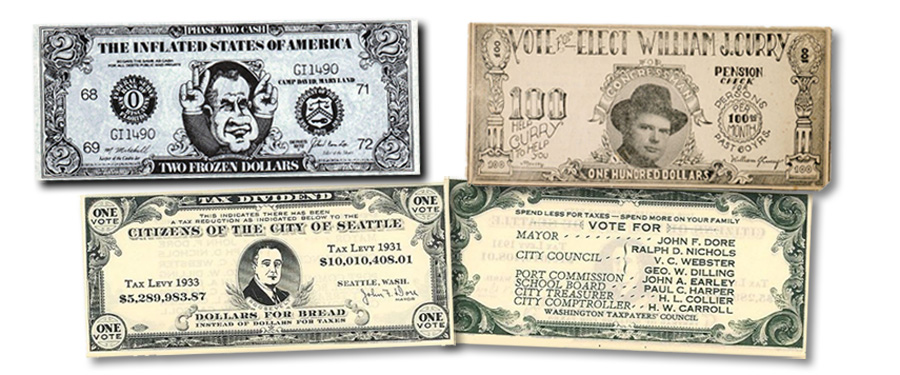
With the November mid-term elections just around the corner most of you are no doubt weary of the seemingly endless barrage of campaign ads on TV, radio, social media and elsewhere. The constant in your face approach of politicians and their backers is nothing new. Over the years candidates and political parties have even turned to paper money (or notes made to appear as money), in order to sway the opinion of the voting public.
This practice goes back at least to the mid-1800s and continues today. William J. Curry employed a rather crudely executed $100 "bill" in his 1950 campaign for Ohio’s 10th Congressional District seat. The note promoted Curry’s platform of establishing a $100 per month pension for persons over 60 years of age. Curry lost the election to long term Congressman Thomas A. Jenkins.
A depression era campaign note by the Washington Taxpayer’s Council promoted candidates running for office in Seattle by drawing on the popularity of then President Franklin D. Roosevelt to attract voters. Roosevelt is pictured on their note, which touts tax reductions for the citizens of Seattle. The back lists candidates for office that citizens are encouraged to vote for.
Not all political notes endorse candidates for office. Some are used for political satire and attack politicians or policies. President Richard Nixon was a popular target of satire notes that attacked his Cold War policies and highlighted inflation which plagued the nation at the time.
Satire notes are still around today and make fun of candidates from all parties. Campaign advertising notes are not seen with any regularity today, as candidates have turned to more advanced (and annoying) methods to get their messages out to the masses. There’s just under a month to go until election day and no doubt the ads will be flying for just a bit more.
I’m Brad Ciociola and I approve this message. No public funds were used for the writing of this blog.





